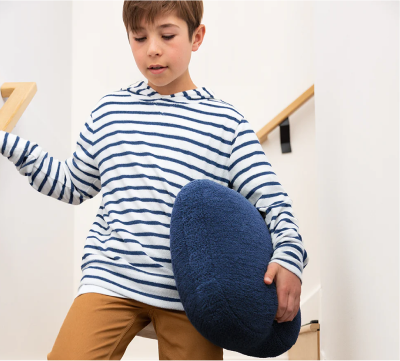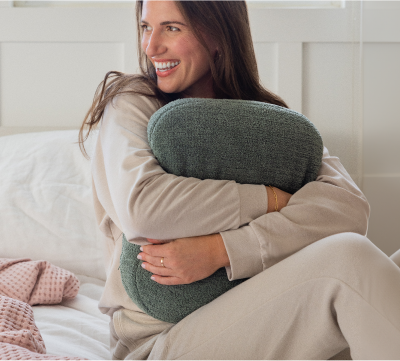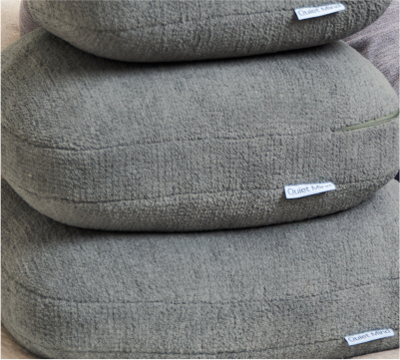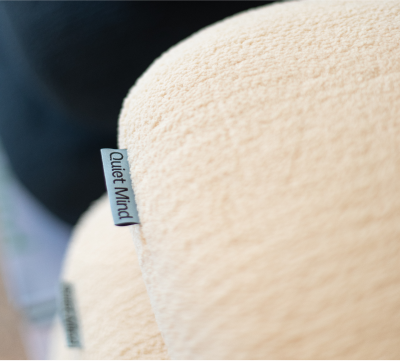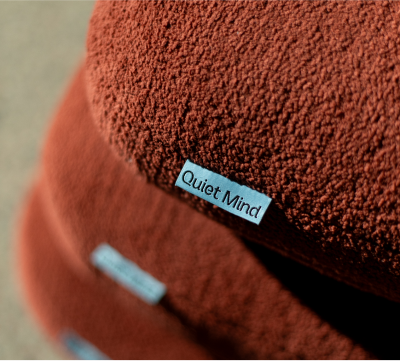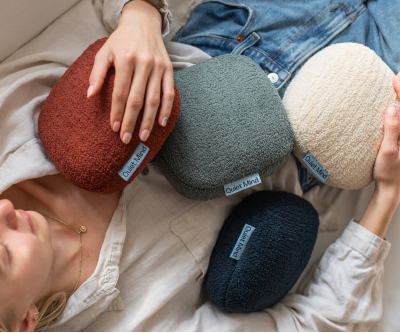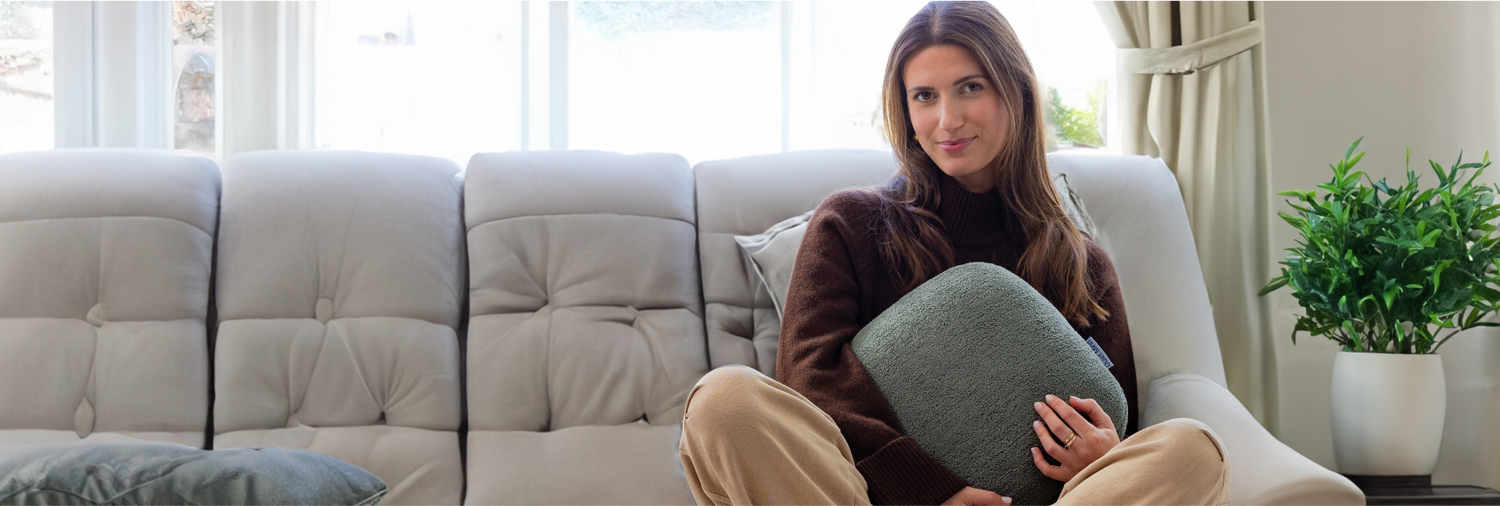Sleep isn’t just about shutting down, it’s about how you’re held while you rest. When you sleep on your side, the right combination of softness and steady support can make the difference between tossing and turning or waking up refreshed.
Weighted blankets have become increasingly popular for their therapeutic benefits, offering a steady, calming weight that mimics the feeling of being gently hugged. This is called deep touch pressure, and it’s known to help reduce anxiety, improve sleep regulation, and promote a better night’s sleep. But the real question is, can a weighted blanket help side sleepers achieve their best sleep without discomfort?
The short answer: yes, if you choose the right weighted blanket for your body’s specific needs. Side sleepers can benefit from weighted blankets in many ways, from falling asleep faster to staying asleep through the night. But it takes the right weight, fabric, and positioning to ensure those benefits are felt without strain.
How Weighted Blankets Work: A Calm Foundation
Weighted blankets are more than just heavier versions of regular blankets. They’re carefully designed to deliver deep touch pressure (DTP) across the body. This sensation stimulates the nervous system in a way that helps the body shift into its rest-and-digest mode, supporting both emotional calm and physical stillness.
When you sleep with a weighted blanket, the steady pressure on the body triggers a series of physiological responses:
- Serotonin boost: Enhances mood and helps prepare the body for rest.
- Melatonin release: Supports natural sleep cycles and helps you stay asleep.
- Cortisol reduction: Lowers stress levels that might otherwise keep you awake.
This combination of effects can be particularly helpful for people with autism spectrum disorder, ADHD, anxiety, or sensory sensitivities, as well as for side sleepers who need extra comfort cues to settle into deep sleep. A weighted pillow applies the same principle but in a more flexible way, placing pressure on the lap, chest, or between the knees, helping side sleepers fine-tune where they feel most supported.
What are the Benefits in Sleep Science Context
The benefits of sleeping with a weighted blanket go beyond comfort:
- Promoting better sleep cycles through consistent sensory input.
- Helping regulate movement during sleep for fewer wakeups.
- Reducing restlessness and nighttime anxiety.
- Providing a sense of security that helps side sleepers get deeper, more restorative rest.
The pressure of the blanket works like a therapeutic tool, offering several benefits at once, from calming a busy mind to physically anchoring the body in a position that feels safe.
At its core, the primary role of a weighted blanket is to combine gentle, evenly distributed pressure with the body’s natural relaxation response, creating an environment where both mind and body can unwind more easily. For those who prefer more flexibility, a weighted pillow can deliver similar grounding pressure without the bulk, making it easier to use daily for both sleep and relaxation.
Why Sleep Position Matters With Weighted Blankets
How you sleep determines how the weight of the blanket interacts with your body, so finding the best position to sleep with a weighted blanket is key to comfort and support. Back sleepers often experience even weight distribution, while stomach sleepers usually need very light blankets to avoid pressure on the chest and neck.
Side sleepers, however, face unique challenges:
- Pressure on the body is uneven and concentrated at shoulders, hips, and knees.
- Joint alignment is more sensitive so even slight misalignment can lead to morning stiffness or lower back pain.
- Heat can build up faster if the blanket isn’t breathable, especially for hot sleepers.
For side sleepers, a weighted blanket can help regulate movement, promote stillness, and encourage relaxation, but only if the size and weight are chosen thoughtfully. When overheating or joint strain becomes a problem, a weighted pillow can be hugged to the chest or placed between the knees, offering the same calming input while relieving pressure on sensitive points.
Are Weighted Blankets Comfortable for Side Sleepers?
The comfort of a weighted blanket for side sleepers depends on three things:
1. Weight of the blanket: Too heavy, and it creates excess pressure on joints; too light, and it won’t provide enough deep touch pressure to be effective.
2. Fabric and fill: Breathable cotton or bamboo is ideal for promoting better temperature regulation.
3. Pillow support: Side sleepers get the best results when the blanket is paired with a supportive pillow between the knees and another under the neck.
When these factors are aligned, weighted blankets can help side sleepers achieve better rest, fewer nighttime disruptions, and a more consistent sleep cycle. For many, sleeping with a weighted blanket every night becomes a soothing ritual that supports deep relaxation and steady sleep quality.
Many side sleepers describe the sensation as being “gently anchored,” making it easier to fall asleep and stay asleep through the night. Some find that adding or even substituting a weighted pillow provides that same anchored feeling while improving breathability and mobility.
Pressure Distribution and Joint Alignment
Side sleeping naturally concentrates weight on one side of the body, meaning the pressure of the blanket is felt more intensely at certain points.
This can be beneficial, steady pressure at the hips and shoulders may signal the nervous system to relax, but only when the pressure is balanced and not excessive.
Weighted blankets are available in different weights and sizes, making it easier to choose a weighted blanket that suits your body type. The goal is to benefit from weighted blankets without experiencing numbness, tingling, or morning stiffness.
Similarly, weighted pillows give side sleepers the ability to control placement; hugging one for chest support, tucking it under the neck, or resting it between the knees for hip alignment, so pressure never builds in uncomfortable ways.
A right weighted blanket for side sleeping should:
- Provide even distribution of weight without bunching.
- Support spinal alignment by working with, not against, your pillow setup.
- Allow for easy movement during sleep without feeling restrictive.
Common Issues for Side Sleepers and How to Address Them
Even the best weighted blanket can cause discomfort if not matched to your specific needs. Here are the most common side sleeper concerns and how to solve them.
Shoulder and Hip Sensitivity
Issue: Concentrated pressure on these joints can cause soreness if the blanket is too heavy.
Quiet Mind’s Expert Recommendation: Choose a weighted blanket that is between 5–10% of your body weight to ensure even weight distribution and comfort for side sleepers.
Neck Alignment
Issue: Without proper pillow support, a weighted blanket may worsen spinal misalignment.
Quiet Mind’s Expert Recommendation: Use a contoured pillow designed for side sleepers to keep your spine neutral and help prevent morning neck pain.
Heat Retention
Issue: Weighted blankets naturally retain more heat due to their density, and may lead to uncomfortable heat during sleep.
Quiet Mind’s Expert Recommendation: Opt for breathable materials like cotton, bamboo, or cooling fabric blends to regulate temperature and prevent overheating. In warmer months, some side sleepers switch to a smaller weighted pillow for calming input without excess heat.
Knee and Lower Back Discomfort
Issue: The sideways bend in the hips and knees can create tension in the lower back and legs.
Quiet Mind’s Expert Recommendation: Place a pillow between the knees to keep hips level, reduce lumbar strain, and allow the blanket’s weight to feel evenly spread.
Mobility and Movement
Issue: Heavier blankets can make it harder to turn or shift positions during the night.
Quiet Mind’s Expert Recommendation: Select a slightly lighter weight or ensure the blanket drapes evenly over both sides of your body to make movement easier while maintaining the grounding effect. For those who value easier movement, Quiet Mind’s weighted pillow can be a flexible alternative.
|
Area |
Concern |
Recommendation |
|
Shoulders |
Compression, tightness |
Choose a lighter blanket; avoid bunching and adjust fill |
|
Hips |
Joint strain |
Place a pillow between knees for proper alignment |
|
Neck |
Poor posture, stiffness |
Use a side-sleeper pillow and keep spine neutral |
|
Lower Back |
Lumbar strain |
Support knees and hips to avoid misalignment |
|
Temperature |
Heat buildup |
Opt for breathable fabrics and cooling designs |
What to Look for in a Weighted Blanket for Side Sleeping
Not every weighted blanket is equally suited for side sleepers. Your goal is to choose the right weighted blanket that delivers the therapeutic benefits of deep touch pressure without creating extra strain on your joints or overheating you during the night.
When you choose a weighted blanket, think about:
- Size and weight relative to your body.
- Fabric for breathability and comfort.
- Fill type for even distribution and quiet movement.
- Your specific needs (e.g., hot sleepers, those with lower back pain, sensory sensitivities).
For those who find these considerations too limiting, weighted pillows can be a simpler option. They avoid issues like blanket overhang or heat retention and can be used alongside your existing bedding without major adjustments.
Best Weight Range for Side Sleepers
The experts at Quiet Mind recommend that you choose a weighted blanket that is about 5–10% of your body weight. This range ensures enough pressure on the body to activate the nervous system’s relaxation response without overloading sensitive areas like the shoulders and hips.
If you are prone to joint pain, sleep hot, or like the freedom to shift position during the night, err on the lighter side. A lighter blanket helps you fall asleep faster, prevents discomfort, and still allows you to benefit from weighted blankets without the drawbacks of excess pressure.
|
Body Weight (lbs) |
Recommended Blanket Weight (lbs) |
|
100–130 |
8–10 |
|
131–160 |
10–12 |
|
161–190 |
12–15 |
|
191+ |
15–18 |
This size and weight chart is not rigid; listening to your body matters most. If you feel the blanket is too heavy to adjust or too light to calm you, there’s no harm in trying a different option. The same applies to pillows, sometimes a single weighted pillow gives you just the right amount of grounding without the complexity of blanket sizing.
Size, Fill, and Fabric
Here are the main factors to consider when choosing the size, fill, and fabric of a weighted blanket:
Size
Weighted blankets are available in different dimensions, from twin to king sizes. For side sleepers, a smaller or mid-sized blanket that covers your body without excessive overhang is often best.
Too much overhang can cause the blanket to pull downward, creating uneven weight distribution and discomfort. For those who want to avoid sizing issues entirely, a weighted pillow sidesteps this problem, delivering deep touch pressure in a compact, manageable size.
Fill
- Glass beads: Small, smooth, and quiet which is ideal for even weight distribution and minimal shifting during the night.
- Plastic poly pellets: Durable but slightly bulkier; can work for those who prefer a more textured feel.
- Natural grains: Organic options like flax or millet offer a soft, earthy weight but may retain more heat.
Weighted pillows also come with different fills, often designed for quiet use and even distribution, which makes them practical for side sleepers who need targeted comfort without bulk.
Fabric
- Cotton: Breathable, soft, and durable; a great choice for hot sleepers.
- Bamboo: Naturally cooling and moisture-wicking, promoting better temperature regulation.
- Minky fleece: Warm and plush, best for cold climates but less ideal for hot sleepers.
The benefits of a weighted blanket are amplified when it matches your temperature preferences and tactile comfort. Hot sleepers may prefer bamboo or lightweight cotton, while cold-natured side sleepers might appreciate a cozy minky fabric.
For those who want less commitment or year-round use, a weighted pillow made with breathable covers can provide comfort in all seasons.
Why Side Sleepers Prefer Lighter Weights
Side sleeping creates concentrated pressure points, shoulders, hips, and knees bear the brunt of the blanket’s load. While heavier blankets can be great for back sleepers, they can be overwhelming for those who sleep on their side.
Weighted blankets can help side sleepers by reducing tossing and turning, but only if the weight is low enough to avoid compressing these sensitive points.
|
Sleep Position |
Ideal Weight Range |
Reason |
|
Side Sleeper |
5–10% |
Reduces joint pressure, enhances comfort |
|
Back Sleeper |
10–12% |
Even distribution supports the whole body |
|
Stomach Sleeper |
<5% |
Minimizes pressure on chest and neck |
Remember: less weight doesn’t mean fewer benefits. Even with a lighter blanket or a single weighted pillow, the deep touch pressure still signals the body to relax, helping you sleep better, stay in deep sleep, and wake up feeling more refreshed.
Signs Your Blanket Is Too Heavy (or Too Light)
A weighted blanket should feel like a steady, grounding presence that gently nudges you toward relaxation rather than becoming a source of strain. If it doesn’t feel supportive and easy to settle under, the weight may not be right for you.
Too Heavy?
If your blanket is overly heavy for your body size, sleep position, or personal comfort, you might notice:
-
Tingling or numbness in shoulders, hips, or legs: Excessive pressure can compress nerves or restrict circulation in certain areas, especially for side sleepers.
-
Overheating or sweating: Heavy blankets often trap more heat, and hot sleepers may struggle to stay cool through the night.
-
Difficulty moving or adjusting position: If turning over feels like lifting a sandbag, the weight is likely too high.
- Morning stiffness or aggravated lower back pain: Extra load on joints and muscles can strain the spine or worsen pre-existing discomfort.
Too Light?
If the blanket isn’t heavy enough, it won’t deliver the deep touch pressure needed to calm the nervous system and improve rest. You may notice:
-
No noticeable calming effect: Without enough weight, the blanket won’t trigger the same sense of security or help slow a racing mind.
-
Frequent tossing and turning: The lack of grounding can make it harder to stay settled in one position.
- Blanket shifts easily or feels “loose” on the body: You may wake to find it sliding off or bunching up, disrupting your rest.
Finding the Right Balance
The ideal weighted blanket should feel grounding yet breathable, offering enough pressure to relax muscles and signal safety to the nervous system while still allowing you to move and adjust positions comfortably.
Finding the right balance is essential. For some side sleepers, that balance comes from blankets. For others, a weighted pillow provides a simpler path: it offers focused calming pressure without the risk of being too heavy or too light across the whole body.
Pros and Cons of Weighted Blankets for Side Sleepers
Weighted blankets can offer both significant benefits and notable challenges for side sleepers. Choosing the right weight, size, and material is key to maximizing comfort while avoiding strain.
Pros of Weighted Blankets for Side Sleepers
-
Promotes better sleep regulation: Deep touch pressure can help the body move smoothly between sleep stages, supporting deeper rest and fewer nighttime wakeups.
-
Therapeutic benefits for specific needs: Can provide steady sensory input that may be calming for those with anxiety, ADHD, or autism spectrum disorder, helping you fall asleep faster and stay asleep longer.
-
Reduces movement during sleep: Limits tossing, turning, and restless leg movements, allowing for a more consistent sleep cycle.
-
Enhances sense of safety and comfort: Creates a cocoon-like feeling that helps many side sleepers relax, reduce stress, and feel secure.
-
Customizable options available: Comes in multiple sizes, fabrics, and fill types, making it easier to choose one that meets specific needs, whether you’re a hot sleeper or have sensitive joints.
Cons of Weighted Blankets for Side Sleepers
-
Heat retention: Can trap warmth, especially in non-breathable fabrics. Hot sleepers should look for cotton, bamboo, or cooling blends.
-
Extra pressure on hips and shoulders: If the weight is too heavy, joint strain or soreness in pressure points may occur.
-
Blanket shifting during the night: Side sleeping’s narrower body contact can cause the blanket to slide. Choosing the correct size and weight can help keep it in place.
-
May feel restrictive for some: Those unaccustomed to weighted blankets may need time to adjust. Starting with a lighter option can ease the transition.
- Requires careful selection: The wrong size or weight can reduce benefits and create discomfort. Personal testing and proper sizing are essential.
This is where weighted pillows shine. They don’t replace blankets entirely, but they solve many of these drawbacks; less heat, less bulk, easier movement, while still giving side sleepers the grounding sensation they need.
Takeaway
For side sleepers, a well-chosen weighted blanket can support deeper, more restorative rest, reduce nighttime movement, and provide therapeutic sensory benefits. To minimize drawbacks like overheating or joint strain, choose breathable fabrics, aim for 5–10% of your body weight, and ensure even weight distribution.
But if a blanket still feels cumbersome, Quiet Mind weighted pillows offer the same deep touch pressure in a smaller, more versatile form. Whether hugged to the chest, placed between the knees, or used during a quiet moment on the couch, they make it easier to experience calm without compromise.
Quiet Mind’s Tips for Side Sleepers Using Weighted Blankets
The right blanket can transform your sleep, but how you use it matters just as much as which one you choose. These expert tips will help you benefit from weighted blankets without causing strain or overheating.
1. Use Breathable Layers
Layering your weighted blanket over a lightweight cotton sheet or thin duvet can regulate temperature and prevent overheating, especially important for hot sleepers.
Breathable layers also make it easier to adjust warmth without losing the therapeutic benefits of deep touch pressure.
2. Prioritize Pillow Support
For side sleepers, pillows are just as important as the blanket.
- Between the knees: Maintains hip alignment and prevents lower back pain.
- Under the neck: Keeps your spine neutral, avoiding morning stiffness.
- Along the front: For those who like to hug something, this can enhance comfort and keep the blanket evenly distributed. Hugging a pillow can enhance comfort and keep the blanket evenly distributed. Quiet Mind’s weighted pillow adds to this by combining comfort and grounding pressure in a single tool.
3. Adjust Blanket Placement
Drape the blanket from your shoulders downward, avoiding direct pressure on the neck. Smooth out any bunching to ensure pressure on the body is evenly distributed. This helps avoid hotspots where weight feels too concentrated.
|
Strategy |
Purpose for Side Sleepers |
|
Breathable Layers |
Prevent overheating, promote better sleep regulation |
|
Pillow Support |
Maintain joint alignment, alleviate strain |
|
Placement Adjustment |
Ensure even weight distribution for comfort and mobility |
By combining these strategies, you can make your weighted blanket part of a bedtime routine that helps you fall asleep faster, stay in deep sleep longer, and wake up feeling restored.
Who Should Avoid Weighted Blankets for Side Sleeping?
While weighted blankets can provide many benefits, they’re not for everyone. If you fall into any of these categories, check with a healthcare provider before use:
- Severe joint pain, inflammation, or arthritis that makes extra pressure uncomfortable.
- Restricted mobility that makes it difficult to adjust the blanket during the night.
- Sleep apnea or other breathing disorders that could be aggravated by weight on the chest.
- Skin sensitivity or conditions that react to pressure or heat buildup.
For these sleepers, a weighted pillow might be a better option, delivering targeted deep touch pressure without covering the entire body.
Weighted Blankets vs Weighted Pillows: Why Pillows Are the Better Option
Weighted pillows offer the same deep-pressure comfort as blankets but with more flexibility, lighter weight, and fewer restrictions. They’re safer for people who need to limit chest pressure or avoid overheating, and they provide targeted support exactly where it’s needed.
|
Feature |
Weighted Blankets |
Weighted Pillows (Quiet Mind) |
|
Pressure Area |
Full-body coverage |
Targeted pressure on chest, lap, or shoulders |
|
Suitability |
Not ideal for those with breathing or mobility issues |
Safe for most users, even with mild joint pain or limited movement |
|
Temperature |
Can trap heat |
Naturally cooler and breathable |
|
Ease of Movement |
Restricts repositioning during sleep |
Easy to adjust or move anytime |
|
Weight Range |
10–30 lbs |
3–8 lbs, lighter and easier to handle |
|
Best For |
Deep rest while lying still |
Daily use, relaxation, and light nighttime grounding |
Overall, weighted pillows are the better option for individuals avoiding weighted blankets. They provide the same calming benefits in a compact, portable form that’s easier to use and maintain.
Quiet Mind Weighted Pillows combine soft, breathable materials and evenly distributed glass bead filling to deliver steady comfort and relaxation without the drawbacks of heavy blankets.
About Quiet Mind
At Quiet Mind, we believe that better sleep starts with feeling secure, supported, and in tune with your body’s needs. Our resources are created to help you make informed choices about tools like weighted blankets, so you can rest in a way that feels natural and restorative.
We focus on practical, evidence-informed strategies that fit real life, whether you’re adjusting your sleep position, selecting the right blanket, or learning how to make your bedroom a calm retreat.
One of our most popular tools is the Quiet Mind weighted pillow, designed to deliver targeted deep touch pressure to the chest, lap, or shoulders.
It’s a versatile alternative for side sleepers who want the soothing benefits of pressure without the full weight of a blanket, perfect for winding down before bed or finding a moment of stillness during the day.
FAQ
Are weighted blankets suitable for side sleepers?
Yes, with proper weight, size, and positioning. Lighter weights and breathable fabrics are best for comfort.
What’s the ideal weight range for side sleepers?
Start with 5–10% of your body weight. Side sleepers typically need less weight than back sleepers to avoid pressure on joints.
What are the benefits of using a weighted blanket for side sleepers?
Weighted blankets may reduce restlessness, promote relaxation, and improve sleep depth by activating the nervous system’s calming response.
Can weighted blankets cause joint pain for side sleepers?
They can, if they’re too heavy or poorly placed. Choosing the right weight and using support pillows helps reduce strain.
How do I prevent overheating with a weighted blanket?
Select breathable fabrics like cotton or bamboo and avoid heavy insulation underneath. Layer thoughtfully.
Should I use the blanket over or under my shoulders?
Try placing it just below your shoulders to avoid neck strain. Comfort comes from consistency, not from pressing on sensitive areas.
Are there weighted blankets made specifically for side sleepers?
While not marketed as such, options with lighter fill, breathable fabric, and narrower cuts often work better for side sleepers.



